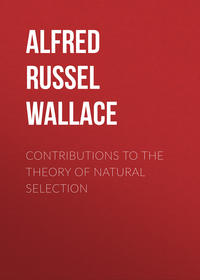 полная версия
полная версияIsland Life; Or, The Phenomena and Causes of Insular Faunas and Floras
Supposed Connection of South Africa and Australia.—There remains, however, the small amount of direct affinity between the vegetation of South Africa and that of Australia, New Zealand, and Temperate South America, consisting in all of fifteen genera, five of which are confined to Australia and South Africa, while several natural orders are better represented in these two countries than in any other part of the world. This resemblance has been supposed to imply some former land-connection of all the great southern lands, but it appears to me that any such supposition is wholly unnecessary. The differences between the faunas and floras of these countries are too great and too radical to render it possible that any such connection should have existed except at a very remote period. But if we have to go back so far for an explanation, a much simpler one presents itself, and one more in accordance with what we have learnt of the general permanence of deep oceans and the great changes that have taken place in the distribution of all forms of life. Just as we explain the presence of marsupials in Australia and America and of Centetidæ in Madagascar and the Antilles, by the preservation in these localities of remnants of once wide-spread types, so we should prefer to consider the few genera common to Australia and South Africa as remnants of an ancient vegetation, once spread over the northern hemisphere, driven southward by the pressure of more specialised types, and now finding a refuge in these two widely separated southern lands. It is suggestive of such an explanation that these genera are either of very ancient groups—as Conifers and Cycads—or plants of low organisation as the Restiaceæ—or of world-wide distribution, as Melanthaceæ.
The Endemic Genera of Plants in New Zealand.—Returning now to the New Zealand flora, with which we are more especially concerned, there only remains to be considered the peculiar or endemic genera which characterise it. These are thirty-two in number, and are mostly very isolated. A few have affinities with Arctic groups, others with Himalayan, or Australian genera; several are tropical forms, but the majority appear to be altogether peculiar types of world-wide groups—as Leguminosæ, Saxifrageæ, Compositæ, Orchideæ, &c. We must evidently trace back these peculiar forms to the earliest immigrants, either from the north or from the south; and the great antiquity we are obliged to give to New Zealand—an antiquity supported by every feature in its fauna and flora, no less than by its geological structure, and its extinct forms of life195—affords ample time for the changes in the general distribution of plants, and for those due to isolation and modification under the influence of changed conditions, which are manifested by the extreme peculiarity of many of these interesting endemic forms.
The Absence of Southern Types from the Northern Hemisphere.—We have now only to notice the singular want of reciprocity in the migrations of northern and southern types of vegetation. In return for the vast number of European plants which have reached Australia, not one single Australian plant has entered any part of the north temperate zone, and the same may be said of the typical southern vegetation in general, whether developed in the Antarctic lands, New Zealand, South America, or South Africa. The furthest northern outliers of the southern flora are a few genera of Antarctic type on the Bornean Alps; the genus Acæna which has a species in California; two representatives of the Australian flora—Casuarina and Stylidium, in the peninsula of India; while China and the Philippines have two strictly Australian genera of Orchideæ—Microtis and Thelymitra, as well as a Restiaceous genus. Several distinct causes appear to have combined to produce this curious inability of the southern flora to make its way into the northern hemisphere. The primary cause is, no doubt, the totally different distribution of land in the two hemispheres, so that in the south there is the minimum of land in the colder parts of the temperate zone and in the north the maximum. This is well shown by the fact that on the parallel of Lat. 50° N. we pass over 240° of land or shallow sea, while on the same parallel of south latitude we have only 4°, where we cross the southern part of Patagonia. Again the three most important south temperate land-areas—South Temperate America, South Africa, and Australia—are widely separated from each other, and have in all probability always been so; whereas the whole of the north temperate lands are practically continuous. It follows that, instead of the enormous northern area, in which highly organised and dominant groups of plants have been developed gifted with great colonising and aggressive powers, we have in the south three comparatively small and detached areas, in which rich floras have been developed with special adaptations to soil, climate, and organic environment, but comparatively impotent and inferior beyond their own domain.
Another circumstance which makes the contest between the northern and southern forms still more unequal, is the much greater hardiness of the former, from having been developed in a colder region, and one where alpine and arctic conditions extensively prevail; whereas the southern floras have been mainly developed in mild regions to which they have been altogether confined. While the northern plants have been driven north or south by each succeeding change of climate, the southern species have undergone comparatively slight changes of this nature, owing to the areas they occupy being unconnected with the ice-bearing Antarctic continent. It follows, that whereas the northern plants find in all these southern lands a milder and more equable climate than that to which they have been accustomed, and are thus often able to grow and flourish even more vigorously than in their native land, the southern plants would find in almost every part of Europe, North America or Northern Asia, a more severe and less equable climate, with winters that usually prove fatal to them even under cultivation. These causes, taken separately, are very powerful, but when combined they must, I think, be held to be amply sufficient to explain why examples of the typical southern vegetation are almost unknown in the north temperate zone, while a very few of them have extended so far as the northern tropic.196
Concluding Remarks on the Last Two Chapters.—Our inquiry into the external relations and probable origin of the fauna and flora of New Zealand, has thus led us on to a general theory as to the cause of the peculiar biological relations between the northern and the southern hemispheres; and no better or more typical example could be found of the wide range and great interest of the study of the geographical distribution of animals and plants.
The solution which has here been given of one of the most difficult of this class of problems, has been rendered possible solely by the knowledge very recently obtained of the form of the sea-bottom in the southern ocean, and of the geological structure of the great Australian continent. Without this knowledge we should have nothing but a series of guesses or probabilities on which to found our hypothetical explanation, which we have now been able to build up on a solid foundation of fact. The complete separation of East from West Australia during a portion of the Cretaceous and Tertiary periods, could never have been guessed till it was established by the laborious explorations of the Australian geologists; while the hypothesis of a comparatively shallow sea, uniting New Zealand by a long route with tropical Australia, while a profoundly deep ocean always separated it from temperate Australia, would have been rejected as too improbable a supposition for the foundation of even the most enticing theory. Yet it is mainly by means of these two facts, that we are enabled to give an adequate explanation of the strange anomalies in the flora of Australia and its relation to that of New Zealand.
In the more general explanation of the relations of the various northern and southern floras, I have shown what an important aid to any such explanation is the theory of repeated changes of climate, not necessarily of great amount, given in Chapters VIII. and IX.; while the whole discussion justifies the importance attached to the theory of the general permanence of continents and oceans, as demonstrated in Chapter VI., since any rational explanation based upon facts (as opposed to mere unsupported conjecture) must take such general permanence as a starting-point. The whole inquiry into the phenomena presented by islands, which forms the main subject of the present volume has, I think, shown that this theory does afford a firm foundation for the discussion of questions of distribution and dispersal; and that by its aid, combined with a clear perception of the wonderful powers of dispersion and modification in the organic world when long periods are considered, the most difficult problems connected with this subject cease to be insoluble.
CHAPTER XXIV
SUMMARY AND CONCLUSION
The Present Volume is the Development and Application of a Theory—Statement of the Biological and Physical Causes of Dispersal—Investigation of the Facts of Dispersal—of the Means of Dispersal—of Geographical Changes Affecting Dispersal—of Climatal Changes Affecting Dispersal—The Glacial Epoch and its Causes—Alleged Ancient Glacial Epochs—Warm Polar Climates and their Causes—Conclusions as to Geological Climates—How far Different from those of Mr. Croll—Supposed Limitations of Geological Time—Time Amply Sufficient both for Geological and Biological Development—Insular Faunas and Floras—The North Atlantic Islands—The Galapagos—St. Helena and the Sandwich Islands—Great Britain as a Recent Continental Island—Borneo and Java—Japan and Formosa—Madagascar as an Ancient Continental Island—Celebes and New Zealand as Anomalous Islands—The Flora of New Zealand and its Origin—The European Element in the South Temperate Floras—Concluding Remarks.
The present volume has gone over a very wide field both of facts and theories, and it will be well to recall these to the reader's attention and point out their connection with each other, in a concluding chapter. I hope to be able to show that, although at first sight somewhat fragmentary and disconnected, this work is really the development of a clear and definite theory, and its application to the solution of a number of biological problems. That theory is, briefly, that the distribution of the various species and groups of living things over the earth's surface, and their aggregation in definite assemblages in certain areas, is the direct result and outcome of a complex set of causes, which may be grouped as "biological" and "physical." The biological causes are mainly of two kinds—firstly, the constant tendency of all organisms to increase in numbers and to occupy a wider area, and their various powers of dispersion and migration through which, when unchecked, they are enabled to spread widely over the globe; and, secondly, those laws of evolution and extinction which determine the manner in which groups of organisms arise and grow, reach their maximum, and then dwindle away, often breaking up into separate portions which long survive in very remote regions. The physical causes are also mainly of two kinds. We have, first, the geographical changes which at one time isolate a whole fauna and flora, at another time lead to their dispersal and intermixture with adjacent faunas and floras—and it was here important to ascertain and define the exact nature and extent of these changes, and to determine the question of the general stability or instability of continents and oceans; in the second place, it was necessary to determine the exact nature, extent and frequency of the changes of climate which have occurred in various parts of the earth,—because such changes are among the most powerful agents in causing the dispersal and extinction of plants and animals. Hence the importance attached to the question of geological climates and their causes, which have been here investigated at some length with the aid of the most recent researches of geologists, physicists, and explorers. These various inquiries led on to an investigation of the mode of formation of stratified deposits, with a view to fix within some limits their probable age; and also to an estimate of the probable rate of development of the organic world; and both these processes are shown to involve, so far as we can judge, periods of time less vast than have generally been thought necessary.
The numerous facts and theories established in the First Part of the work are then applied to explain the phenomena presented by the floras and faunas of the chief islands of the globe, which are classified, in accordance with their physical origin, in three groups or classes, each of which are shown to exhibit certain well-marked biological features.
Having thus shown that the work is a connected whole, founded on the principle of tracing out the more recondite causes of the distribution of organisms, we will briefly indicate the scope and object of the several chapters, by means of which this general conception has been carried out.
Beginning with simple and familiar facts relating to British and European quadrupeds and birds, I have defined and shown the exact character of "areas of distribution," as applied to species, genera, and families, and have illustrated the subject by maps showing the peculiarities of distribution of some well-known groups of birds. Taking then our British mammals and land-birds, I follow them over the whole area they inhabit, and thus obtain a foundation for the establishment of "zoological regions," and a clear insight into their character as distinct from the usual geographical divisions of the globe.
The facts thus far established are then shown to be necessary results of the "law of evolution." The nature and amount of "variation" is exhibited by a number of curious examples; the origin, growth, and decay of species and genera are traced, and all the interesting phenomena of isolated groups and discontinuous generic and specific areas are shown to follow as logical consequences.
The next subject investigated is the means by which the various groups of animals are enabled to overcome the natural barriers which often seem to limit them to very restricted areas, how far those barriers are themselves liable to be altered or abolished, and what is the exact nature and amount of the changes of sea and land which our earth has undergone in past times. This latter part of the inquiry is shown to be the most important as it is the most fundamental; and as it is still a subject of controversy, and many erroneous views prevail in regard to it, it is discussed at some length. Several distinct classes of evidence are adduced to prove that the grand features of our globe—the position of the great oceans and the chief land-areas—have remained, on the whole, unchanged throughout geological time. Our continents are shown to be built up mainly of "shore-deposits"; and even the chalk, which is so often said to be the exact equivalent of the "globigerina ooze" now forming in mid-Atlantic, is shown to be a comparatively shallow-water deposit formed in inland seas, or in the immediate vicinity of land. The general stability of continents has, however, been accompanied by constant changes of form, and insular conditions have prevailed over every part in succession; and the effect of such changes on the distribution of organisms is pointed out.
We then approach the consideration of another set of changes—those of climate—which have probably been agents of the first importance in modifying the specific forms as well as the distribution of animals. Here again we find ourselves in the midst of fierce controversies. The occurrence of a recent glacial epoch of great severity in the northern hemisphere is now universally admitted, but the causes which brought it on are matter of dispute. But unless we can arrive at these causes, as well as at those which produced the equally well demonstrated mild climate in the Arctic regions, we shall be quite unable to determine the nature and amount of the changes of climate which have occurred throughout past ages, and shall thus be left without a most important clue to the explanation of many of the anomalies in the distribution of animals and plants.
I have therefore devoted three chapters to a full investigation of this question. I have first given such a sketch of the most salient facts as to render the phenomena of the glacial epoch clear and intelligible. I then review the various suggested explanations, and, taking up the two which alone seem tenable, I endeavour to determine the true principles of each. While adopting generally Mr. Croll's views as to the causes of the "glacial epoch," I have introduced certain limitations and modifications. I have pointed out, I believe, more clearly than has hitherto been done, the very different effects on climate of water in the liquid and in the solid state; and I have shown, by a variety of evidence, that without high land there can be no permanent snow and ice. From these facts and principles the very important conclusion is reached, that the alternate phases of precession—causing the winter of each hemisphere to be in aphelion and perihelion each 10,500 years—would produce a complete change of climate only where a country was partially snow-clad; while, whenever a large area became almost wholly buried in snow and ice—as was certainly the case with Northern Europe and America during the glacial epoch—then the glacial conditions would be continued and perhaps even intensified when the sun approached nearest to the earth in winter, instead of there being at that time, as Mr. Croll maintains, an almost perpetual spring. This important result is supported by reference to the existing differences between the climates of the northern and southern hemispheres, and by what is known to have occurred during the last glacial epoch; and it is shown to be in complete harmony with the geological evidence as to interglacial mild periods.
Discussing next the evidence for glacial epochs in earlier times, it is shown that Mr. Croll's views are opposed by a vast body of facts, and that the geological evidence leads irresistibly to the conclusion that during a large portion of the Secondary and Tertiary periods, uninterrupted warm climates prevailed in the north temperate zone, and so far ameliorated the climate of the Arctic regions as to admit of the growth of a luxuriant vegetation in the highest latitudes yet explored. The geographical condition of the northern hemisphere at these periods is then investigated, and it is shown to have been probably such as to admit the warm tropical waters freely to penetrate the land, and to reach the Arctic seas by several channels; and, adopting Mr. Croll's calculations as to the enormous quantity of heat that would thus be conveyed northwards, it is maintained that the mild Arctic climates are amply accounted for. With such favourable geographical conditions, it is shown, that changes of excentricity and of the phases of precession would have no other effect than to cause greater differences of temperature between summer and winter; but, wherever there was a considerable extent of very lofty mountains the snow-line would be lowered, and the snow-collecting area being thus largely increased a considerable amount of local glaciation might result. Thus may be explained the presence of enormous ice-borne rocks in Eocene and Miocene times in Central Europe, while at the very same period all the surrounding country enjoyed a tropical or sub-tropical climate.
The general conclusion is thus reached, that geographical conditions are the essential causes of great changes of climate, and that the radically different distribution of land and sea in the northern and southern hemispheres has generally led to great diversity of climate in the Arctic and Antarctic regions. The form and arrangement of the continents is shown to be such as to favour the transfer of warm oceanic currents to the north far in excess of those which move towards the south, and whenever these currents had free passage through the northern land-masses to the polar area, a mild climate must have prevailed over the whole northern hemisphere. It is only in very recent times that the great northern continents have become so completely consolidated as they now are, thus shutting out the warm water from their interiors, and rendering possible a wide-spread and intense glacial epoch. But this great climatal change was actually brought about by the high excentricity which occurred about 200,000 years ago; and it is doubtful if a similar glaciation in equally low latitudes could be produced by means of any such geographical combinations as actually occur, without the concurrence of a high excentricity.
A survey of the present condition of the earth supports this view, for though we have enormous mountain ranges in every latitude, there is no glaciated country south of Greenland in N. Lat. 61°. But directly we go back a very short period, we find the superficial evidences of glaciation to an enormous extent over three-fourths of the globe. In the Alps and Pyrenees, in the British Isles and Scandinavia, in Spain and the Atlas, in the Caucasus and the Himalayas, in Eastern North America and west of the Rocky Mountains, in the Andes of South Temperate America, in South Africa, and in New Zealand, huge moraines and other unmistakable ice-marks attest the universal descent of the snow-line for several thousand feet below its present level. If we reject the influence of high excentricity as the cause of this almost universal glaciation, we must postulate a general elevation of all these mountains about the same time, geologically speaking—for the general similarity in the state of preservation of the ice-marks and the known activity of denudation as a destroying agent, forbid the idea that they belong to widely separated epochs. It has, indeed, been suggested, that denudation alone has lowered these mountains so much during the post-tertiary epoch, that they were previously of sufficient height to account for the glaciation of all of them; but this hardly needs refutation, for it is clear that denudation could not at the same time have removed some thousands of feet of rock from many hundreds of square miles of lofty snow-collecting plateaus, and yet have left moraines, and blocks, and even glacial striæ, undisturbed and uneffaced on the slopes and in the valleys of these same mountains.
The theory of geological climates set forth in this volume, while founded on Mr. Croll's researches, differs from all that have yet been made public, in clearly tracing out the comparative influence of geographical and astronomical revolutions, showing that, while the former have been the chief, if not the exclusive, causes of the long-continued mild climates of the Arctic regions, the concurrence of the latter has been essential to the production of glacial epochs in the temperate zones, as well as of those local glaciations in low latitudes, of which there is such an abundance of evidence.
The next question discussed is that of geological time as bearing on the development of the organic world. The periods of time usually demanded by geologists have been very great, and it was often assumed that there was no occasion to limit them. But the theory of development demands far more; for the earliest fossiliferous rocks prove the existence of many and varied forms of life which require unrecorded ages for their development—ages probably far longer than those which have elapsed from that period to the present day. The physicists, however, deny that any such indefinitely long periods are available. The sun is ever losing heat far more rapidly than it can be renewed from any known or conceivable source. The earth is a cooling body, and must once have been too hot to support life; while the friction of the tides is checking the earth's rotation, and this cannot have gone on indefinitely without making our day much longer than it is. A limit is therefore placed to the age of the habitable earth, and it has been thought that the time so allowed is not sufficient for the long processes of geological change and organic development. It is therefore important to inquire whether these processes are either of them so excessively slow as has been supposed, and I devote a chapter to the inquiry.









